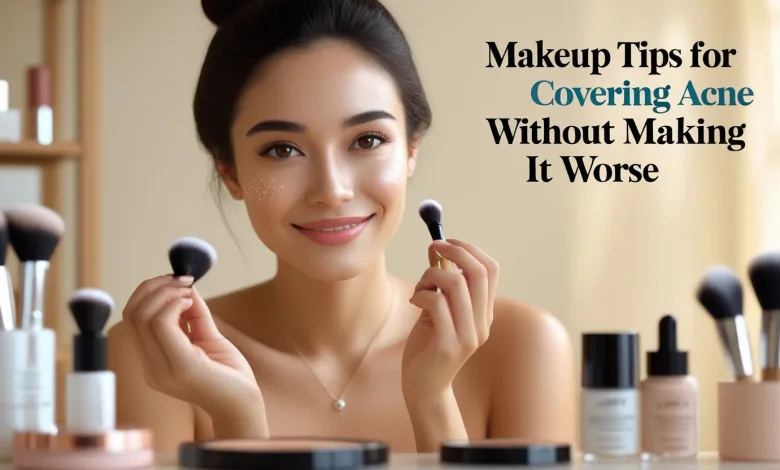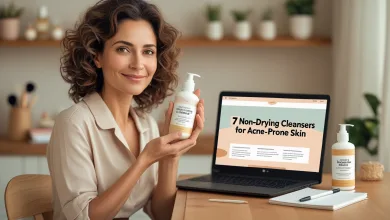Makeup Tips for Covering Acne Without Making It Worse

Dealing with acne is tough enough without worrying about whether your makeup is making things worse. In this comprehensive guide, we’ll explore how to effectively conceal breakouts with makeup while actually helping your skin heal – because covering acne and caring for your skin aren’t mutually exclusive goals.
The Skincare-Makeup Connection: Setting the Foundation
Let’s face it – when you’re dealing with acne, the relationship between your skincare and makeup becomes super important. You can’t just slap any old foundation over active breakouts and expect magic to happen! In fact, the wrong approach might leave you caught in a frustrating cycle: breakouts lead to more makeup, which leads to more breakouts… and on and on it goes.
The good news? You can absolutely cover acne effectively while supporting your skin’s healing process. It’s all about understanding what your skin needs and choosing products that won’t sabotage your efforts. Before we dive into specific makeup tips for covering acne, let’s talk about prepping your canvas properly. Because honestly, what you do before applying makeup is just as crucial as the makeup itself when you’re dealing with breakouts.
Prep Work: Creating the Perfect Canvas
Gentle Cleansing Is Non-Negotiable
Before you even think about reaching for that concealer, make sure your face is properly cleansed. And I’m not talking about harsh scrubbing that’ll irritate those already angry zits! Opt for a gentle, non-comedogenic cleanser that removes impurities without stripping your skin’s natural moisture barrier.
According to dermatologist Dr. Shereene Idriss, “Using harsh cleansers can disrupt your skin barrier, which actually triggers more oil production and potentially more breakouts”. When your skin is dealing with acne, it’s already in a state of inflammation, so treat it kindly. Look for cleansers containing ingredients like salicylic acid which can help control acne while cleansing, but in a formula gentle enough for daily use.
Strategic Moisturizing Is Your Secret Weapon
Okay, I know what you’re thinking – “Moisturizer? On my oily, acne-prone skin? No way!” But hear me out on this. Skipping moisturizer is actually one of the biggest mistakes you could make when applying makeup tips for covering acne. When your skin is dehydrated, it compensates by producing more oil, which can lead to – you guessed it – more breakouts!
Choose an oil-free, non-comedogenic moisturizer that won’t clog your pores. Gel-based formulas containing hyaluronic acid are fantastic for acne-prone skin because they deliver hydration without heaviness. According to a study published in the Journal of Clinical and Aesthetic Dermatology, proper hydration can actually help reduce the appearance of acne and improve the effectiveness of topical treatments.
Prime With Purpose
A good primer creates a smooth canvas for makeup application and helps your coverage last longer. But when you’re dealing with acne, your primer needs to do more than just prep your skin – it should actively benefit it too.
Look for primers with:
- Salicylic acid to help treat existing breakouts
- Niacinamide to reduce inflammation and redness
- Silica to absorb excess oil throughout the day
- Green color-correcting tints to neutralize redness
“Primers that contain silicones can create a protective barrier between your skin and makeup, which may help prevent pore-clogging,” explains makeup artist Katie Jane Hughes. Just be sure to thoroughly cleanse at the end of the day to prevent any buildup.
Product Selection: Choosing Acne-Friendly Makeup
Foundation Formulas That Won’t Make Acne Worse
When it comes to makeup tips for covering acne, foundation selection is absolutely critical. The wrong formula can not only look cakey over textured skin but might actually exacerbate your breakouts. No thanks!
Mineral-based foundations are often a solid choice for acne-prone skin. According to dermatologist Dr. Joshua Zeichner, “Mineral makeup containing zinc oxide can have a calming effect on inflamed skin and provide mild sun protection”. Zinc oxide has natural anti-inflammatory properties that can be beneficial when dealing with active breakouts.
Other great options include:
- Water-based foundations (they’re typically less comedogenic than oil-based formulas)
- “Acne-fighting” foundations containing salicylic acid (but avoid these if you’re already using multiple acne treatments, as over-treatment can irritate skin)
- Medium-coverage foundations labeled “non-comedogenic” or “non-acnegenic”
What to avoid? Super matte, long-wear formulations often contain higher levels of ingredients that can potentially clog pores when worn for extended periods. Also steer clear of foundations with added fragrance, as these can further irritate sensitive, acne-prone skin.
Concealer Strategies That Work
Let’s talk about concealer – your best friend when it comes to targeted coverage for those stubborn spots. But not all concealers are created equal when it comes to covering blemishes!
For spot-concealing acne, look for:
- Stick or pot concealers for precise application and maximum coverage
- Formulas containing kaolin clay to absorb oil around blemishes
- Anti-inflammatory ingredients like bisabolol or allantoin
- Concealers specifically designed for blemish coverage
A study in the International Journal of Cosmetic Science found that makeup products containing certain clays can actually help absorb excess sebum throughout the day, potentially benefiting acne-prone skin when used appropriately.
Application Techniques: The How Matters as Much as the What
Layering Like a Pro
When covering acne, less is definitely more. Building thin layers strategically will give you much better results than globbing on product and hoping for the best (we’ve all been there!).
Here’s a step-by-step approach that makeup artist Lisa Eldridge recommends:
- Apply a thin layer of foundation all over your face using a damp makeup sponge
- Let this first layer set for about a minute
- Go in with concealer just on the spots that need extra coverage
- Gently pat (don’t rub!) the concealer using your ring finger or a small precision brush
- Set only the concealed areas with a light dusting of translucent powder
“The mistake many people make is applying too much product everywhere,” explains Eldridge. “This creates an obvious makeup mask that draws more attention to texture issues, not less.”
Tools That Make a Difference
The tools you use to apply your makeup can significantly impact both how well it covers acne and how it affects your skin’s health. While your fingers might seem convenient, they can transfer bacteria to already compromised skin.
Instead, consider:
- Disposable makeup sponges (replace frequently!)
- Synthetic brushes (they’re less likely to harbor bacteria than natural hair brushes)
- Silicone applicators (these don’t absorb product and can be thoroughly sanitized)
Whatever tools you choose, make sure you’re cleaning them regularly. According to a study published in the Journal of Applied Microbiology, makeup brushes can harbor harmful bacteria that may worsen acne if not properly sanitized. Aim to deep clean your brushes at least weekly, and consider using a daily brush cleaner spray between washes.
Color Correction: The Secret to Natural-Looking Coverage
One of the most effective makeup tips for covering acne that professionals use is color correction. This technique neutralizes discoloration before you apply foundation, resulting in more natural-looking coverage with less product.
Different colored correctors address specific issues:
- Green neutralizes redness from active inflammatory acne
- Yellow helps with purple/blue discoloration from healing blemishes
- Peach works well on darker skin tones to hide post-inflammatory hyperpigmentation
Celebrity makeup artist Sir John, who works with clients like Beyoncé, notes that “Color correcting is what allows you to use less foundation overall. When you neutralize discoloration first, you don’t need to build up as much coverage, which means a more skin-like finish”.
When applying color correctors:
- Use a tiny amount directly on the discolored area
- Tap gently to blend the edges
- Allow it to set for a moment before applying foundation
- Apply foundation lightly over the corrected areas
Setting Your Makeup: Longevity Without Compromising Skin Health
After putting in all that work to cover your acne without aggravating it, the last thing you want is for your makeup to slide off by midday. However, the traditional heavy powdering approach isn’t ideal for acne-prone skin.
Instead, try these acne-friendly setting techniques:
Strategic Powder Placement
Apply setting powder only where absolutely necessary – typically the T-zone and directly on concealed blemishes. Use a small fluffy brush for precision placement rather than coating your entire face.
Look for non-comedogenic setting powders containing silica or clay, which can help absorb oil throughout the day without clogging pores. Dermatologist Dr. Whitney Bowe recommends mineral-based powders for acne-prone skin, noting that “certain minerals like zinc and titanium dioxide have anti-inflammatory properties that can be calming for acne”.
Setting Sprays With Benefits
A good setting spray can lock your makeup in place while actually providing skincare benefits. Look for options containing:
- Niacinamide to control oil and reduce inflammation
- Zinc PCA for antibacterial properties
- Aloe vera to soothe irritated skin
- Cucumber extract for cooling and anti-inflammatory benefits
Avoid setting sprays with alcohol high on the ingredient list, as these can be drying and potentially irritating to acne-prone skin.
Throughout the Day: Maintenance Without Messing Up Your Makeup
Let’s be real – when you have acne, your skin tends to get oilier throughout the day, which can make your carefully applied makeup start to break down. How you maintain your look matters greatly for both appearance and skin health.
Blotting > Powdering
Rather than continuously adding more powder throughout the day (which can lead to cakey-looking skin and potentially clogged pores), use blotting papers to absorb excess oil without disturbing your makeup.
“Blotting papers remove the oil without removing your makeup or depositing potentially pore-clogging ingredients onto already compromised skin,” explains dermatologist Dr. Ranella Hirsch.
Touch-Up Techniques That Won’t Make Acne Worse
If you do need to touch up during the day:
- First blot away excess oil
- Apply a tiny amount of concealer only where needed using a clean applicator
- Gently tap to blend
- Set with the smallest dusting of powder possible
Avoid touching your face throughout the day, as this can transfer bacteria from your hands to your skin and makeup.
Removal: The Final Crucial Step in Your Makeup Routine
Perhaps the most important of all makeup tips for covering acne is how you remove your makeup at the end of the day. Sleeping in makeup can clog pores and worsen breakouts, no matter how “skin-friendly” your products claim to be.
Double Cleansing: The Gold Standard
For acne-prone skin wearing makeup regularly, double cleansing isn’t just a trend – it’s a necessity. This two-step process ensures you’re thoroughly removing all makeup without stripping your skin:
- First cleanse with an oil-based cleanser or micellar water to dissolve makeup
- Follow with a gentle water-based cleanser formulated for acne-prone skin
According to a study published in the Journal of Cosmetic Dermatology, proper makeup removal is one of the most critical steps in preventing cosmetic-induced acne.
Post-Cleansing Care
After removing your makeup, don’t skip your acne treatment products. In fact, applying them to freshly cleansed skin maximizes their effectiveness. Follow with an appropriate nighttime moisturizer to help repair your skin barrier while you sleep.
FAQs: Your Burning Questions About Covering Acne With Makeup
Is it bad to put makeup on active acne?
It’s not necessarily bad to apply makeup over acne, provided you’re using non-comedogenic products and proper application techniques. The key is to choose makeup that won’t exacerbate breakouts and to ensure thorough removal at the end of the day. In fact, some makeup products contain ingredients like salicylic acid that can actually help treat acne while providing coverage.
How can I cover acne without making it look worse?
The secret to covering acne without emphasizing texture is using thin layers and targeted application. Apply a light layer of foundation all over, then use a small precision brush to apply concealer just on the blemishes themselves, gently patting to blend. Set minimally with powder, focusing only on the areas with concealer.
Which makeup brands are best for acne-prone skin?
While individual skin reactions vary, some brands consistently formulate products with acne-prone skin in mind, including Clinique, bareMinerals, Jane Iredale, and Cover FX. Always check ingredient lists regardless of brand claims, and patch test new products before applying them all over your face.
Can I use makeup if I’m using prescription acne medication?
Yes, but with some precautions. Many prescription acne treatments increase skin sensitivity and dryness. If you’re using medications like retinoids or benzoyl peroxide, you might need to adjust your makeup routine accordingly – opt for more hydrating formulas and be particularly gentle with application and removal. When in doubt, consult with your dermatologist about specific product recommendations.
How often should I replace my makeup if I have acne?
Makeup used on acne-prone skin should be replaced more frequently than the standard recommendations. Consider replacing your foundation and concealer every 6 months, powder products annually, and be vigilant about any changes in product color, smell, or texture. Additionally, never “pump” your mascara wand or share makeup products, as these practices can introduce bacteria.
Wrapping Things Up: Finding Your Balance
Living with acne doesn’t mean you have to give up makeup – it’s about finding the right products and techniques that work with your skin, not against it. The makeup tips for covering acne we’ve discussed are designed to help you achieve the coverage you want while still supporting your skin’s healing process.
Remember that what works for someone else might not work for you, and that’s completely normal. Acne is an incredibly individual skin condition, and finding your perfect routine might involve some trial and error. Be patient with your skin, and don’t hesitate to consult with a dermatologist if your acne persists despite your best efforts.
The most important takeaway? You deserve to feel confident in your skin, whether that means embracing your acne, covering it up, or finding a middle ground that feels right for you. Your makeup routine should be empowering, not another source of stress in your skincare journey.






